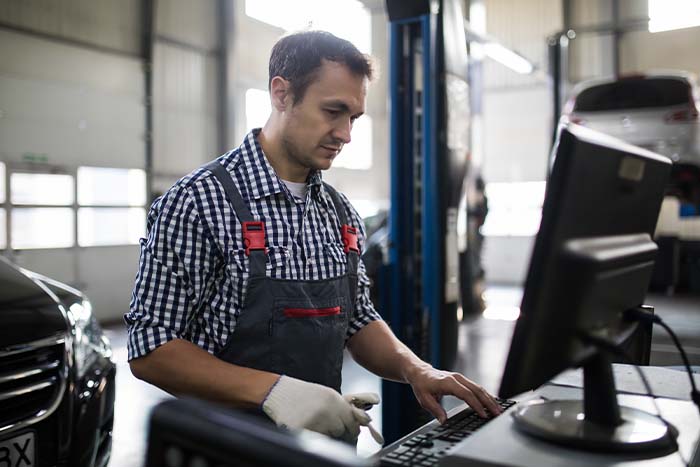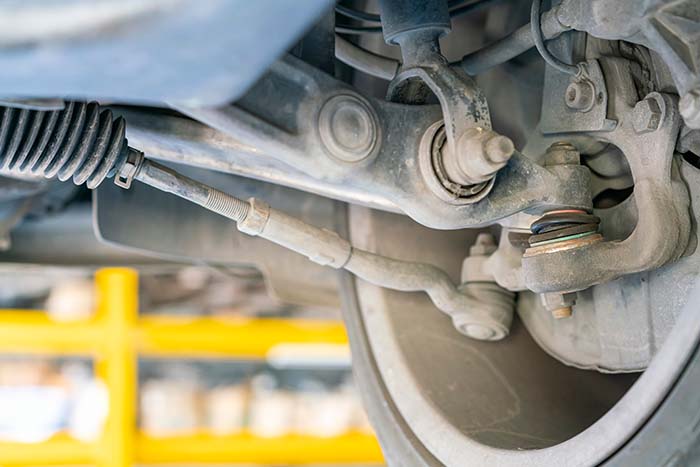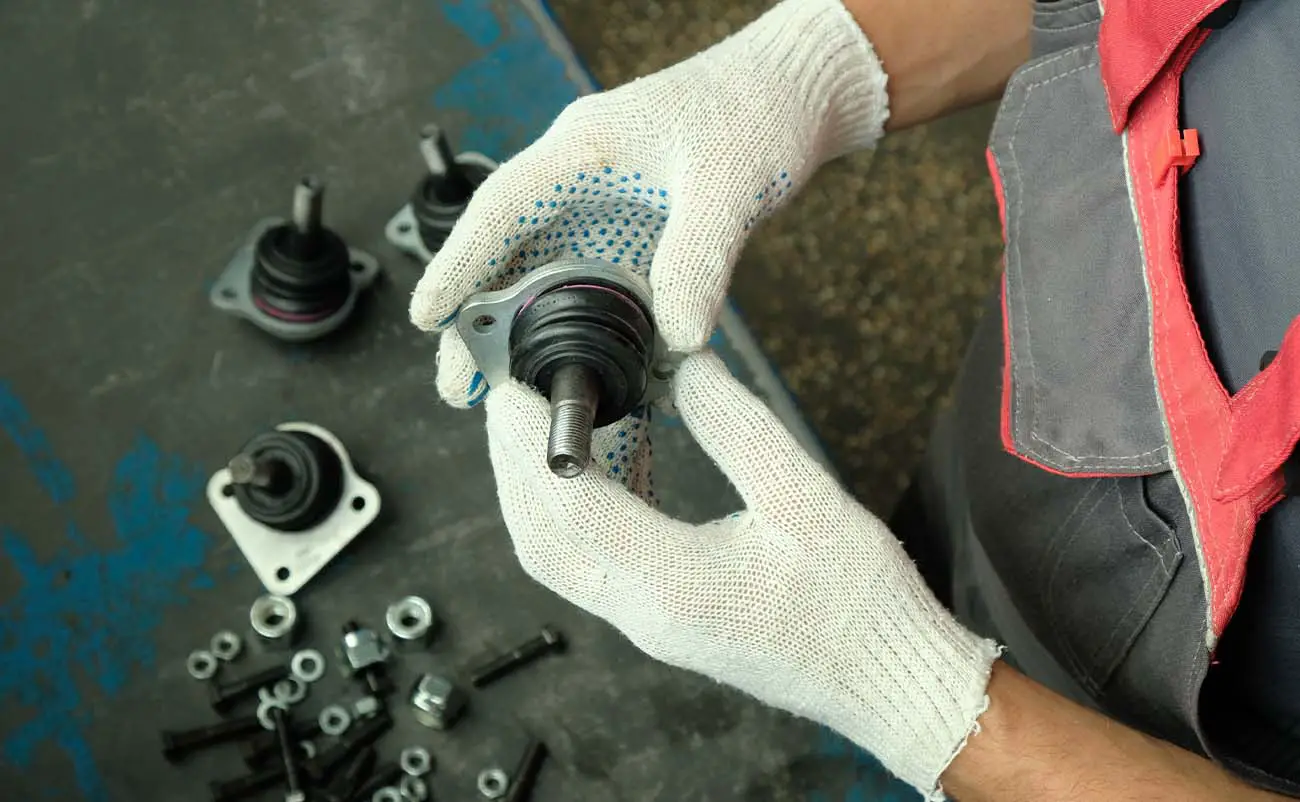Ball joints are critical pieces of your car’s suspension system, and one that is damaged could result in a loss of steering ability. Can you imagine driving down the road and suddenly not being able to steer your vehicle? What would you do if you turned the steering wheel, but your car did not respond? While that is a worst-case scenario, it could happen if you have a ball joint that fails. That is why it is important to have your ball joints inspected regularly and replace them if there are any signs of wear or damage. Keep reading as we tell you what a ball joint is, how it works, and how much you can expect to pay to replace one.
Table of Contents
Average Ball Joint Replacement Cost

So, what is the cost to replace ball joints? You might be surprised to learn that replacing a ball joint is not overly expensive. You can expect to pay around $300 in most cases, including both parts and labor. Most ball joints cost about $100 to $150, while the labor costs will run you $150 to $200. An independent repair shop will almost always be cheaper than the dealership as well. In addition, you might find some manufacturers like MOOG sell ball joints for vehicles as cheap as $30.
Some other factors might affect the total price of this repair. Higher-end car models usually require more expensive parts. For instance, you might find that replacing a ball joint on your Mercedes or BMW might come with a bill of $500, while the same job on a Honda, Toyota, Ford, or Chrysler might only be $250. In addition, your bill might be higher if other parts need replacing at the same time. It is possible that the ball joints on both the upper and lower control arms need replacing instead of just one. If damage to your steering knuckle has occurred, then it might also need replacing. The above prices are simply averages for replacing a single ball joint with no other parts or work required.
What Is A Ball Joint?
A ball joint on a vehicle works very much like a ball joint in the human body. Think about your shoulder or hip. The joint itself is much like a cup on one side and a ball on the other. The ball can rotate in all directions inside the cup. In the case of the human body, it allows your arm or leg to move and rotate in many different directions inside the joint. In your vehicle, a ball joint allows your control arm and steering knuckle to move and rotate with each other.
A rubber boot typically covers the ball joints in your vehicle for protection. This helps keep the grease inside for lubrication, and it also keeps dust, dirt, and other debris out of the joint. If debris finds its way inside the joint, then it can cause damage and prevent the ball joint from functioning as it should. When a mechanic inspects your vehicle, they will often examine the boot for damage in addition to checking the wear and tear of the joint itself.
What Does A Ball Joint Do?
We’ve already discussed what a ball joint is and how it works, but what exactly does a ball joint do? Why does your car even need one? The ball joints on your vehicle connect the steering knuckle to your car’s control arms and the wheel hub assembly. As your car drives down the road, your wheels go over bumps, and the ball joint allows your wheels to move up and down and remain on the road. Without the function of the ball joint, your wheels might lose contact with the ground as your car bumps down the road.
In addition, when you turn the steering wheel, the ball joint can rotate and turn the wheel assembly. So, the ball joint allows the wheel assembly to both move up and down and rotate. Some vehicles have both lower ball joints and upper ball joints, while others have only lower joints. Now you can see why a ball joint is such a critical piece of your car’s suspension. Without these joints, it would be challenging to drive your car down the road safely.
Signs You Have A Bad Ball Joint

Now that you know how vital a ball joint is, how can you tell when one is going bad? There are a few different things that you can watch for, and we will describe those here. If you notice any of these symptoms, you should head to your mechanic to diagnose and repair them.
— Steering Wheel Vibration
A failing ball joint might start to show up as a vibration in the steering wheel. Ball joints should fit tightly within each other, so there should be no play or looseness in the joint. If there is, then the joint will vibrate inside the cup as your car drives. Since the joint is connected to your steering knuckle, this vibration can get transferred to your steering wheel. If you feel your steering wheel vibrating as you drive, then it might mean that your ball joint is getting loose due to wear and tear. It would be best if you had it inspected right away to determine whether it needs replacement.
— Suspension Noises
Another common symptom of a bad ball joint is a noise coming from your vehicle’s suspension. This will most often sound like a clunking noise. What generally happens is that the cushioning material inside the joint will wear out. When it does, the metal ball is clunking into the cup with no cushion. This is when you can hear the metal on metal clunk. Once you hear this noise, complete failure is probably not far away. Go ahead and get your vehicle checked out at an auto repair shop right away.
— Uneven Tire Wear / Misalignment
A worn ball joint can also harm your car’s alignment and tire wear. If you notice excessive wear on your front tires, mainly just one tire, then the ball joint might be to blame. The worn ball joint might be preventing that particular tire from moving up and down or turning as it should. Perhaps there is play in the joint that causes the wheel and tire to wobble. Either of those scenarios can cause the tire to wear more quickly than it should.
— Car Drifts From Side To Side
If you notice your car drifting from side to side as you drive, then a ball joint is probably starting to wear. Since ball joints help keep your car’s motion under control, a bad one will cause more activity than usual. This symptom will tend to show up more at higher speeds. If you are going slow, then you likely will not feel the drifting much. However, at highway speeds, it will start to become more apparent. This can also be dangerous as it could cause you to lose control of your vehicle if the drifting gets bad enough. Make sure that you get this issue corrected quickly.
How Often To Replace Ball Joints
You might be wondering when to replace ball joints. Ball joints are not typically items that need to be replaced as a preventative measure. You will generally only replace your ball joint when one gets worn or goes bad. In most cases, a ball joint should last at least 100,000 miles, and you might find that ball joints will go well beyond this mileage under good driving conditions. Since most ball joints last for so long, they are rarely covered under warranty. However, if your ball joint fails while your car is under warranty, then you can probably get it replaced free of charge.
However, if your vehicle is constantly subjected to rough driving conditions, this will put additional strain on your ball joints. If you live on a very bumpy road or you frequently take your vehicle off-road, then you will probably find yourself replacing a ball joint before your car hits 100,000 miles. Rough driving conditions will not only shorten the lifespan of your ball joints, but they will also shorten the lifespan of your other front suspension components like your lower and upper control arms, struts, tie rods, and control arm bushings.
You will typically know when to replace a ball joint because you will be experiencing one of the symptoms that we have already mentioned. If you are unsure, you should take your vehicle to a mechanic to have it inspected, and they can confirm whether the ball joint is bad and needs replacing. If the joint has failed, then do not delay in getting a new ball joint installed.
Can You Replace A Ball Joint Yourself?
Yes, you can replace a ball joint yourself. However, a ball joint repair is somewhat of a demanding job that requires some special tools. If you do not have the proper tools and expertise to perform the job, you should not attempt it independently. Someone with the right tools and knowledge will likely be able to save themselves a couple of hundred dollars in labor costs by performing the work alone.
You will first need to remove the old ball joint from the car. This process starts by removing the front wheel where the lousy ball joint is located. Next, you will need to remove the axle nut and then the caliper. Make sure that you are careful not to damage your brake lines or ABS wiring. This is also an excellent time to look at your wheel bearings and inspect them for damage. You can save yourself a little money on the wheel-bearing replacement cost if you do the job while things are already torn apart. Next, remove the control arm from the steering knuckle and remove the steering knuckle from the ball joint. You can now use a ball joint press or splitter to remove the old ball joint.
Reassembly involves the same steps seen above but in reverse. You will need to use a ball joint press to install the new ball joint. If equipped, you will also need to install the new grease fitting on the ball joint. If your vehicle has a sealed joint, then there will be no grease fitting. Reattach the steering knuckle and control arm. Reinstall the caliper, axle nut, and wheel. It would be best if you always had a wheel alignment performed after the job is completed. A front-end alignment is critical after taking apart your front suspension pieces. Thankfully, the cost of a wheel alignment is usually only about $100. Remember that this car repair is relatively tricky, so do not attempt the job unless you are entirely confident that you can complete it.
The Bottom Line
Not many people fully understand what a ball joint is or how it works, but it is vital to your car’s suspension. A bad ball joint can have many negative consequences, so you should have it replaced right away when it starts to fail. Thankfully, replacement cost is not extremely expensive. The parts and labor together will usually run you around $300 for a ball joint replacement. If you are reasonably experienced and have the right tools, you can even do the job yourself to save money.
Frequently Asked Questions
Can you drive a car with a bad ball joint?
Yes, technically, you can drive with a bad ball joint in most cases. You might notice a vibration in the steering wheel, a clunking sound, or even your car drifting. If your vehicle is starting to drift, then you should not continue to drive it. Complete failure of the ball joint can even cause your wheel to become separated from your power steering and suspension. This could be extremely dangerous.
What are the benefits of replacing ball joints?
There are several benefits to replacing worn ball joints. First, your vehicle should drive more smoothly and steadily. You should experience fewer vibrations and clunks with a new ball joint. You will also experience less tire wear. A bad ball joint can cause a tire to wear much more quickly than it should. This can save you quite a bit of money on tire replacement.
How do you replace a ball joint?
Some people wonder how to replace ball joints on their own. Replacing a ball joint requires some specialized knowledge and tools. You will need an axle wrench, torque wrench, and ball joint press to do the job. It requires removing the car’s wheel, axle nut, and caliper. It would be best if you then disconnected the control arm and steering knuckle. Finally, remove the old ball joint, and then complete the steps in reverse order to reassemble things. You will also need to perform a wheel alignment after the new ball joint has been installed.
What is the difference between an upper ball joint and a lower ball joint?
The difference is almost self-explanatory. The upper ball joint generally sits above the wheels and connects to the upper control arm. Conversely, the lower ball joint sits lower and connects to the lower control arm. Not all vehicles have both types of ball joints. When a car only has one ball joint per wheel, it is usually a lower ball joint.

